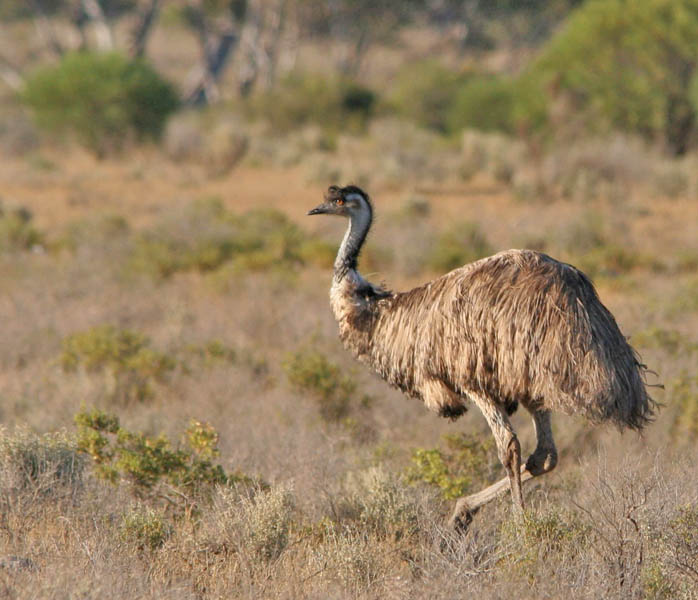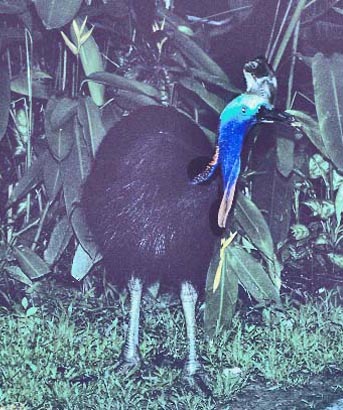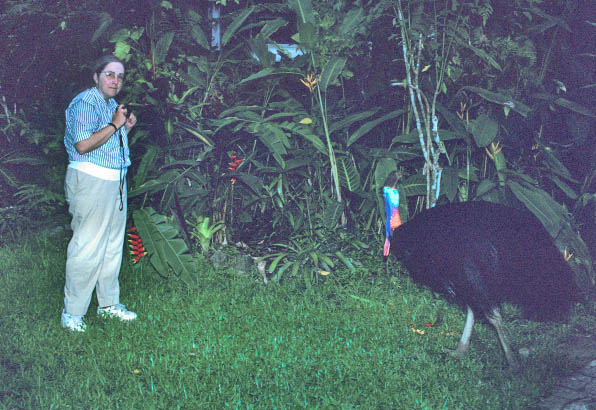
a web page by Don Roberson |
 |
CASSOWARIES & EMU Casuariidae |
||
|
||
Emu (above; male with brood of young) is a large flightless bird of grasslands and light eucalypt forest in Australia. The three closely-related cassowaries occur in the dense lowland rainforest of New Guinea and northeastern Australia. The one occurring in Australia is Southern Cassowary (left; a very nice roadside photo of an adult and young by Murray Lord). |
||
The Emu has a long and turbulent history with man. Early white settlers eagerly sought the eggs and appreciated the beef-like flavor of the meat. They have been bred on farms around the world for meat and to use the skin as leather. In 1932 the Australian government, under pressure from farmers who said emus were hurting their crops, sent an army artillery unit to Western Australia. It was planned that 20,000 emus should be killed by using machine guns and grenades. So began the Great Emu War. "However, the birds proved to be more adept in terms of both camouflage and strategic retreat than the soldiers themselves, and they dispersed rapidly in small groups when they were shot at. After a month of endless and fruitless pursuit, during which it is reported that they only managed to kill 12 Emu, the Royal Australian Artillery had to admit defeat and they withdrew. In the wake of this fiasco, the farmers decided to build long, high, Emu-proof fencelines" (Folch 1992). There is but one species of Emu today — the Larger or Spotted Emu — but there were other species of emu on King Island and Kangaroo Island, off Tasmania, until early in the 19th century. These are often lumped together as Dwarf Emu Dromaius baudinanus. There was another emu on Tasmania that is usually considered a subspecies of the Larger Emu. |
||
To quote Folch (1992): "Observation of wild cassowaries is very difficult, so as yet very little is known about their behavior. On detecting an approaching human, a bird usually disappears into the dense vegetation before it is seen, with the result that tracks and droppings are very often the only evidence of its presence." That is certainly true throughout the cassowary habitats in New Guinea but Southern Cassowary (above, by Murray Lord, as is the sign) can occasionally be seen at roadside near Mission Beach, Queensland, Australia. At that local the risk of being hit by traffic is quite real. As to New Guinea, cassowaries seem almost mythological. In 1983 a couple friends and I traveled throughout Papua New Guinea. We visited lowland forest at the Baiyer River Sanctuary, a location on the northern slope of the central mountains and now considered too dangerous for westerners to visit. Back then, though, an active research program existed and we stayed at the research station. One morning, while walking in the forest with a local guide, the guide stopped — whispered "cassowary!" — and up ahead we saw the back end of a large, black, bushy form disappear into the jungle. From the thick coarse hair it was a cassowary — the local Dwarf Cassowary C. bennetti — but for many years that hind-end glimpse was all I had of a tangible cassowary. My friend Steve Bailey spent several months doing research in northern Papua New Guinea. He tells of walking in the forest one day and seeing what he thought was a local villager, with a brightly painted red-and-blue face, standing on the path. That was, of course, a cassowary. Steve got one quick look and it was gone. Steve and I both spent time in lowland forests of Irian Jaya where the Northern (or Single-wattled) Cassowary C. unappendiculatus occurs. For our efforts we have seen tracks and droppings. |
||
|
||
It took multiple visits to coastal Queensland, Australia, to get a better view any any cassowary. It is Southern (or Double-wattled) Cassowary (above) that occurs here. In January 1998, Rita Carratello (that's her with the Cassowary) booked three days at "Cassowary House" in Kuranda in the mountains northwest of Cairns, Queensland. Then operated by John & Rita Squire (they've since retired but the new owners have retained it as a birders' bed & breakfast), they advised that if we were willing to spend two days in their garden, our chances were good. When John & Rita Squire first opened, there were no cassowaries visiting the property. Instead, they put up their sign (reading "Cassowary House") and ten years ago a male Southern Cassowary made his initial visit ("It just goes to show," says John, "that cassowaries can read."). "Father," the Squire's name for this initial male, was still visiting occasionally. Sometimes "Aunt," his usual mate now that "Mother" had died, visits separately (cassowaries are solitary in the wild). Some summers they bring chicks. One cannot predict when any other wild cassowary will visit. At 5:30 p.m. on our first day, "Father," the original male, materialized out of the forest and tromped to the kitchen door, demanding to be fed (above). John brought out huge bowls of fruit which "Father" gobbled down greedily. It was all very eerie. "Father" was not the least bit concerned with us but had his own agenda. After finishing all of the fruit he disappeared into the forest as mysteriously as he had arrived. |
||
Photos: Both photos of Emu Dromaius novaehollandiae were in the Flinders Range, South Australia, on 19 Nov 2009. Murray Lord photographed the adult and young Southern Cassowary Casuarius casuarius at Mission Beach, Queensland, Australia, in Sep 2015. My photos of Southern Cassowary are from "Cassowary House," Kuranda, Queensland, Australia, on 3 Jan 1998. Now run by Phil Gregory and his wife, "Cassowary House" can be booked by visiting birders; see their web site. Uncredited photos © Don Roberson. Credited photos © Murray Lord, as credited, and used with permission; all rights reserved. Bibliographic note: There is no family book but this group is covered in standard texts on ratites, and Folch (1992) provides a nice introduction with some fine photos. A discussion of New Guinea species, with more fine photos, is in Coates (1985). Literature cited:
|
 The Emu
(right) is a big, shaggy bird that spends most of its time foraging.
Emus graze on grass and plants much of the day, and gather at
waterholes or river edges to drink. They remind me of avian llamas. Yet
despite this active grazing, they are omnivorous and will eat large
quantities of insects if they come upon them. The breeding strategy of
Emu is successive polyandry. Pairing occurs in the southern summer
(December-January) when the females start a "drumming" call. The male
collects materials for a rudimentary nest and the female lays 5 to 15
eggs therein. After that, it is the male that incubates the eggs and
raises the young, although the female may stay in the general vicinity.
It takes about five months for the checks to go out on their own. They
are born precocial but in need of protection, During this period the
male in very aggressive, and may even drive away his mate (Folch 1992).
The Emu
(right) is a big, shaggy bird that spends most of its time foraging.
Emus graze on grass and plants much of the day, and gather at
waterholes or river edges to drink. They remind me of avian llamas. Yet
despite this active grazing, they are omnivorous and will eat large
quantities of insects if they come upon them. The breeding strategy of
Emu is successive polyandry. Pairing occurs in the southern summer
(December-January) when the females start a "drumming" call. The male
collects materials for a rudimentary nest and the female lays 5 to 15
eggs therein. After that, it is the male that incubates the eggs and
raises the young, although the female may stay in the general vicinity.
It takes about five months for the checks to go out on their own. They
are born precocial but in need of protection, During this period the
male in very aggressive, and may even drive away his mate (Folch 1992).

